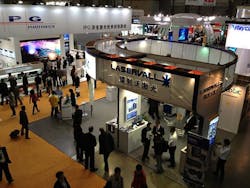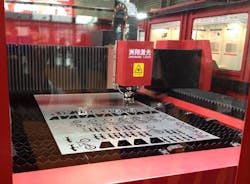Shanghai, China--Attendees of the 2013 Laser World of Photonics (http://www.laserfocusworld.com/blogs/photon-focus/2013/03/nlia-and-clusters-advance-china-s-domestic-laser-industry.html) conference in Shanghai, China were greeted with LOUD music and BIG exhibits in halls W1, W2, and W3 of the Shanghai New International Expo Centre (SNIEC). IPG Photonics' (Oxford, MA) booth encompassed 150 square meters and Han's Laser (Shenzhen, China) covered 210 square meters of the total 28,750 square meters of the 539-exhibitors-strong convention halls—a 25% growth in floor space compared to last year (http://www.laserfocusworld.com/blogs/photon-focus/2012/03/photonics-shows-strength-in-shanghai.html).
Exhibition
Now I've never been to Shanghai before, let alone China, so some of my comments may reflect my "greenhorn" status. But I must say that photonics exhibitions in the United States typically don't include music booming from loudspeakers as I observed at more than one exhibit in the SNIEC halls. Hall W1 housed imaging, optics, and optical metrology exhibits, while halls W2 and W3 contained laser systems for production engineering.The supersized exhibit spaces made the conference seem larger than even Photonics West (which had double the number of exhibitors—1238 in 2013 versus 539 for Laser China 2013). With foot traffic at more than 36,000 visitors (36,042 the official count), Laser China beats out Photonics West (with just more than 20,700 registered attendees in 2013); however, the Laser China foot traffic was no doubt assisted by the collocation of Electronica China 2013, Productronica China 2013, and SOLARCON China 2013, which were located in the halls across the huge central mall of the SNIEC.
In addition to the overwhelming presence of security (armed and unarmed) both at the exposition entrances and in the exposition halls themselves, all attendees were required to pass their bags through a scanner. Despite the numerous beeps—even a few times for my own bags—I was never asked to have my bags rescreened or opened and checked, nor did I see anyone else garner extra screening after a beep. And tweeting from the show? Not possible in China, where Twitter and Facebook are not allowed.
More than a few times, colleagues reminded me that safety had been tremendously improved since the first Laser World of Photonics China conference in 2006 when laser displays were apparently active, with beams passing through the exposition aisles and booths. Today, systems are either shielded or not actively cutting and welding on the show floor--darn; flying beams in action would have been more exciting than static displays!
Conference program
In addition to the exhibits, the "Photonics Congress China" included the 8th International Conference on Laser Processes and Components (LPC 2013), Optics Frontier—The 8th Conference on Laser Technology and Optoelectronics and Release of 2012 China Optics Outstanding Achievements and Products, training courses and short courses on fiber lasers, quantum-cascade lasers, infrared imaging technology and applications, and laser beam analysis and propagation techniques, and a workshop on laser product safety protection standards.
Each of the 20 to 25 minute presentations within the two-and-a-half days of the LPC 2013 conference covered the latest laser materials processing technologies and applications, with discussions on global laser markets, fiber laser and direct diode technologies, laser additive manufacturing achievements, and laser micromaterials processing of solar cells and medical devices. The LPC 2013 conference alone attracted 429 attendees. In his keynote on "Laser Additive Manufacturing for Difficulty Processing Metal Large-Scale Complex Integral Components: Challenges and Development," professor Huaming Wang from Beijing University of Aeronautics and Astronautics described how laser melting deposition (LMD) thermal distortions and cracking problems had essentially been eliminated through research. He said that LMD mechanical properties were now better than forged components and crack propagation rates were one order of magnitude lower than forged counterparts for approximately 4 m long x 3 m wide x 2 m high parts. But in the question and answer period from the audience, Wang said that LMD is only economical for very large sized, small-volume parts, and that high-volume applications (like automotive) would likely not see LMD for a very long time.
Unfortunately, I was unable to attend the Optics Frontier portion of the conference, which featured around 35 (25 minutes each) presentations over two days on topics as diverse as nonlinear effects in plasmonic metamaterials, seeded free-electron lasers, polymer-based waveguides, high-power diode lasers, laser-driven laboratory astrophysics, type II FPA detectors, holography, beam combining, adaptive optics, and fiber lasers.
Maybe it was the loud music and the hustle of hundreds of people trying to get where they needed to be in such a huge conference venue, but the conference and exhibits resonated with an energy level akin to the San Jose days of Photonics West when additional tents were needed to accommodate the overflowing exhibition. As Laser Focus World continues to strengthen its worldwide focus, I'm hopeful that many of the contacts made at the conference will begin to generate more editorial content from Chinese companies in future issues of the magazine.

Gail Overton | Senior Editor (2004-2020)
Gail has more than 30 years of engineering, marketing, product management, and editorial experience in the photonics and optical communications industry. Before joining the staff at Laser Focus World in 2004, she held many product management and product marketing roles in the fiber-optics industry, most notably at Hughes (El Segundo, CA), GTE Labs (Waltham, MA), Corning (Corning, NY), Photon Kinetics (Beaverton, OR), and Newport Corporation (Irvine, CA). During her marketing career, Gail published articles in WDM Solutions and Sensors magazine and traveled internationally to conduct product and sales training. Gail received her BS degree in physics, with an emphasis in optics, from San Diego State University in San Diego, CA in May 1986.

